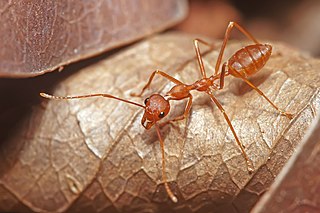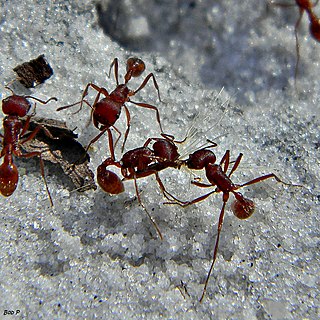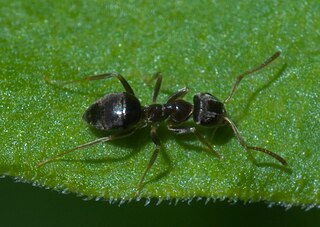
The Formicinae are a subfamily within the Formicidae containing ants of moderate evolutionary development.

Weaver ants or green ants are eusocial insects of the family Formicidae. Weaver ants live in trees and are known for their unique nest building behaviour where workers construct nests by weaving together leaves using larval silk. Colonies can be extremely large consisting of more than a hundred nests spanning numerous trees and containing more than half a million workers. Like many other ant species, weaver ants prey on small insects and supplement their diet with carbohydrate-rich honeydew excreted by small insects (Hemiptera). Weaver ant workers exhibit a clear bimodal size distribution, with almost no overlap between the size of the minor and major workers. The major workers are approximately 8–10 mm (0.31–0.39 in) in length and the minors approximately half the length of the majors. Major workers forage, defend, maintain, and expand the colony whereas minor workers tend to stay within the nests where they care for the brood and 'milk' scale insects in or close to the nests.

Harvester ant, also known as harvesting ant, is a common name for any of the species or genera of ants that collect seeds, or mushrooms as in the case of Euprenolepis procera, which are stored in the nest in communal chambers called granaries. They are also referred to as agricultural ants. Seed harvesting by some desert ants is an adaptation to the lack of typical ant resources such as prey or honeydew from hemipterans. Harvester ants increase seed dispersal and protection, and provide nutrients that increase seedling survival of the desert plants. In addition, ants provide soil aeration through the creation of galleries and chambers, mix deep and upper layers of soil, and incorporate organic refuse into the soil.

Paratrechina is one of seven ant genera in the Prenolepis genus-group from the subfamily Formicinae. Six species are included in Paratrechina; one of which, the longhorn crazy ant, is a widespread, pantropical pest.

Malikussaleh is an Acehnese who established the first Muslim state of Samudera Pasai in the year 1267. His original name was Mara Silu, Merah Silu, or Meurah Silu. It was said he saw an ant as big as a cat, he caught it and ate it. He named the place Samudera, meaning ocean in Sanskrit (samudra). King Mara Silu later converted to Islam, given an Ayyubid name of al-Malik al-Ṣālih. He married neighbour Perlak (Peureulak) Kingdom's daughter and had two sons. According to Hikayat Raja-raja Pasai, he met the Islamic prophet Muhammad in dream thus accepts conversion of Islam. Another source claimed a prince Malik from Aceh sailed across the sea to Beruas and established a sultanate there.

Dinomyrmex is a monotypic genus of ant containing the species Dinomyrmex gigas or giant forest ant. D. gigas is a large species of ant, native to Southeast Asian forests. It is one of the largest ants in existence, measuring in at 20.9 mm (0.82 in) for normal workers, and 28.1 mm (1.11 in) for the soldiers. Honeydew makes up 90% of their diet, but they will also consume insects and bird droppings. The ant is an effective forager, utilizing both efficient communication and recruitment. A handful of these ants may meet at night to engage in what has been observed to be ritual battle. These fights can continue for several months.

The wildlife of Cambodia is very diverse with at least 162 mammal species, 600 bird species, 176 reptile species, 900 freshwater fish species, 670 invertebrate species, and more than 3000 plant species. A single protected area, Keo Seima Wildlife Sanctuary, is known to support more than 950 total species, including 75 species that are listed as globally threatened on the IUCN Red List. An unknown amount of species remains to be described by science, especially the insect group of butterflies and moths, collectively known as lepidopterans.
Euprenolepis echinata is a Southeast Asian species of ant in the subfamily Formicinae.
Euprenolepis maschwitzi is a Southeast Asian species of ant in the subfamily Formicinae.
Euprenolepis thrix is a Southeast Asian species of ant in the subfamily Formicinae.
Euprenolepis variegata is a Southeast Asian species of ant in the subfamily Formicinae.
Euprenolepis zeta is a Southeast Asian species of ant in the subfamily Formicinae.

Euprenolepis procera is a species of ant found in the rainforests of South East Asia. It was first described by Carlo Emery, an Italian entomologist, in 1900. In 2008, Witte & Maschwitz discovered that E. procera specialises in harvesting mushrooms in the rainforest for food, representing a new, previously unreported feeding strategy in ants.

Rock Entertainment is a 24/7 Southeast Asian English-language television channel owned by Rock Entertainment Holdings. Launched in 2013, it was initially called RTL CBS Asia Entertainment Network, a joint-venture of RTL Group and CBS Studios International. This channel launched on September 1, 2013, which focuses on entertainment and variety shows and broadcast in high-definition. Within 2 years, the channel became available in 2015 to Philippine cable viewers with a separate feed.

Euprenolepis is a Southeast Asian genus of ants in the subfamily Formicinae with eight recognized species.

Nylanderia is a large genus of ants in the subfamily Formicinae. The genus has a nearly cosmopolitan distribution with species inhabiting a wide array of habitats in almost all geographic regions. Nylanderia, currently containing over 110 species, is an ecologically important genus, with some species reported as being invasive. The ants are small to medium in size and range in color from pale yellow to black.

Rock Action is a Southeast Asian English-language movie channel serving Southeast Asia, owned by Rock Entertainment Holdings.
Euprenolepis negrosensis is an ant species that belongs to the genus Euprenolepis. Described by Wheeler in 1930, they are normally found in South East Asia.

Ant eggs refer to both the eggs and pupae of weaver ants eaten in several countries across Southeast Asia, especially Laos and Northeastern Thailand (Isan). They are high in protein and enjoyed for their sourness and pop when eaten along with soups, omelets, and salads.

Lasiini is a tribe of ants in the family Formicidae. There are about 10 genera and more than 450 described species in Lasiini.












